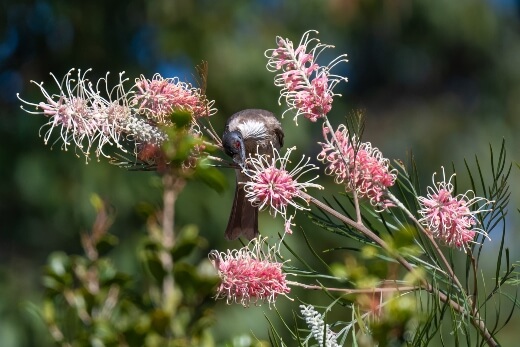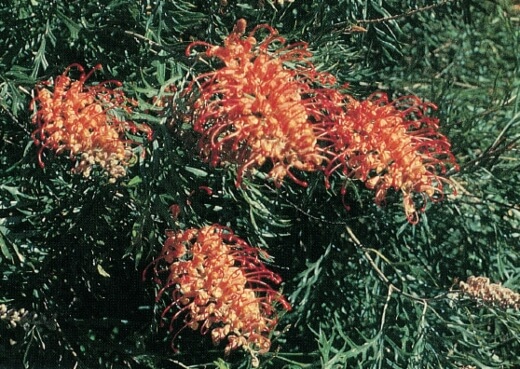Introducing Grevillea ‘Coconut Ice’
This Grevillea cultivar is the combination of the parent plants Grevillea bipinnatifida and Grevillea banksii. Grevillea bipinnatifida x banksii ‘Coconut Ice’ has big pinkish brush shaped flowers that are present almost throughout the year.
Parent plant Grevillea bipinnatifida is found in many parts of south western WA, and has been used to create other popular Grevillea cultivars like ‘Robyn Gordon’. Grevillea banksii is a type of Grevillea from Queensland.
More...

Source: Native Plant Project
Family: | Proteaceae |
|---|---|
Genus: | Grevillea |
Parentage: | G. bipinnatifida x G. banksii |
Common Name: | Grevillea ‘Coconut Ice’ |
Origin: | Australia |
Location: | Outdoor |
Type: | Shrub |
Grevillea Coconut Ice Height | Up to 2 metres |
Sun requirements: | Sunny/light shade |
Foliage Colour: | Green |
Flower Colour: | Cream, pink |
Flowering: | Spring, summer, winter |
Fruit: | None |
Maintenance level: | Low |
Poisonous for pets: | No |
How to Grow Grevillea ‘Coconut Ice’

Source: Austraflora
Propagating Grevillea ‘Coconut Ice’
You can quite easily propagate your own Grevillea ‘Coconut Ice’ from semi-hardwood cuttings that have been taken towards the end of summer. This type of cutting would be a section of the plant where the new growth for the season has started to firm up.
The base of the cutting should ideally be hard, and then the tip soft. When taking your cuttings, aim for a length between 10 and 15 cm and be sure to cut just underneath a node.
Take off the leaves on the lower part of the cutting as well as the tip, and then make a cut about 2 cm long on the side of the base of the stem. Dip this cut end into rooting hormone and then plant your cutting into a container with any normal cutting compost.
Offer the cuttings enough water and ensure the compost stays moist until the cuttings have rooted themselves. In the winter time you can get rid of any dead leaves and only water the cuttings if the compost feels dry.
When spring arrives, you can then start hardening off your Grevillea ‘Coconut Ice’ cuttings.
How to Care for Grevillea ‘Coconut Ice’
Sunlight
Grevillea ‘Coconut Ice’ can grow in full sun or part shade, but you’ll see the best flowering in full sun.
Watering
You can water your Grevillea ‘Coconut Ice’ regularly for the first 8 to 12 weeks while the shrub is establishing itself. After that period, you can then move to occasional watering. This grevillea doesn’t enjoy lots of rain or roots that are wet.
Soil
Grevillea ‘Coconut Ice’ can be flexible when it comes to soil type. It just needs to be well-draining. A clay loam or sandy soil will work well and aim for a neutral pH. If you’re dealing with a heavy soil, you can add in perlite or vermiculite to help air circulation.
Fertiliser
We recommend using a native or low-phosphorus fertiliser for your Grevillea ‘Coconut Ice’. A good time to do this is when you see buds starting to form. Fertilising after pruning the shrub also helps recovery.
Pruning
Grevillea ‘Coconut Ice’ can handle quite a bit of pruning. The best time to do this is after flowering has finished. The pruning process helps to stimulate new growth.


Get Your Free Guide:
Master Growing Australian Natives eBook
A Must Have Complete Guide for Every Australian Garden
Get Your Free Guide:
Master Growing Australian Natives eBook
A Must Have Complete Guide for Every Australian Garden

Source: Plant Native
Grevillea ‘Coconut Ice’ Pests and Diseases
Grevillea ‘Coconut Ice’ is mostly pest and disease free. If the shrub is exposed to a long period of wet and humid conditions, it can be susceptible to leaf fungus which then causes leaf drop.
Grevillea ‘Coconut Ice’ Frequently Asked Questions
What kind of environment does Grevillea ‘Coconut Ice’ grow well in?
The shrub is suitable for any low maintenance garden, and will live well in a cool climate, or growing in a coastal garden. It can also grow well in sub-tropical and Mediterranean climates.
How long does it take for Grevillea ‘Coconut Ice’ to reach maturity?
10 to 20 years.
Sign up to our newsletter for more plant profiles on other Grevillea species and cultivars.
Wrapping Up Our Grevillea ‘Coconut Ice’
Grevillea ‘Coconut Ice’ is a wonderful shrub to be featured in your garden. It works well to create a screen or hedge as it has a dense frame, and offers up its lovely flowers most of the year in shades of pink/orange and cream.
This native is loved by birds who feast on its nectar but also like to nest in the prickly leaves. Since the Grevillea ‘Coconut Ice’ is both tolerant of frost and drought, it’s not difficult to keep happy.
Published on March 29, 2023 by Nathan Schwartz
Last Updated on October 18, 2025




